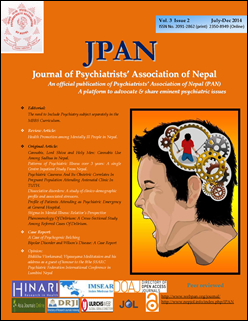Patterns of Psychiatric Illness over 3 years: A single Centre Inpatient Study From Nepal
DOI:
https://doi.org/10.3126/jpan.v3i2.12382Keywords:
Psychiatry inpatients, Pattern of illness, Socio-demographic profileAbstract
Introduction: Inpatient psychiatric patients are a major group of our treatment domain and they are different from outpatients in certain characteristics. In this study, we assessed the patterns of psychiatric illnesses along with socio-demographic variables in patients admitted in a psychiatry ward of a tertiary hospital over three consecutive years.
Methods: This is a retrospective review of all patients admitted in psychiatry ward Tribhuvan University Teaching Hospital over a three year period between 2067 Baisakh to 2069 Chaitra (2010 April to 2013 April) by reviewing in-patient admission charts from medical records section of the hospital. Descriptive analysis was done by using SPSS version 19; Chicago, IL, with p value of <0.05 being considered statistically significant.
Results: There were a total of 881 patients admitted in the psychiatry ward during the study period (281 patients in 2067, 303 in 2068 and 297 in 2069). Patients in the age group of 20-30 years comprised the majority (n=295; 33.5%) of the total population followed by age group 10-20 years (n=239; 27.1%). Males constituted 50.3% of the total patients. Most of the patients belonged to the central developmental region (n=580; 65.8%). Brahmins comprised the majority (n=374; 42.5%) and 98.8% of the patients were Hindus. The most common diagnosis was schizophrenia and related disorders (25.5%) followed by acute and transient psychotic disorders, ATPD (14.4%). Majority of the patients (n=422; 47.9%) had hospital stay duration of 7-14 days. About 98% of patients were discharged with no cases of mortality over three years studied. Overall trend in those three years was similar except for ethnicity, diagnosis, and duration of stay (p≤0.001).
Conclusion: We conclude that schizophrenia and related disorders were the most common diagnosis and 20- 30 years age group was the most commonly afflicted age- group among psychiatry inpatients. This adds insight to our understanding of predominant psychiatric illness in inpatients and how they differ from outpatients aiding in scaling of services in inpatients.
J Psychiatric Association of Nepal Vol .3, No.2, 2014, pp:15-19
DOI: http://dx.doi.org/10.3126/jpan.v3i2.12382
Downloads
Downloads
Published
How to Cite
Issue
Section
License
This license enables reusers to distribute, remix, adapt, and build upon the material in any medium or format, so long as attribution is given to the creator. The license allows for commercial use.




